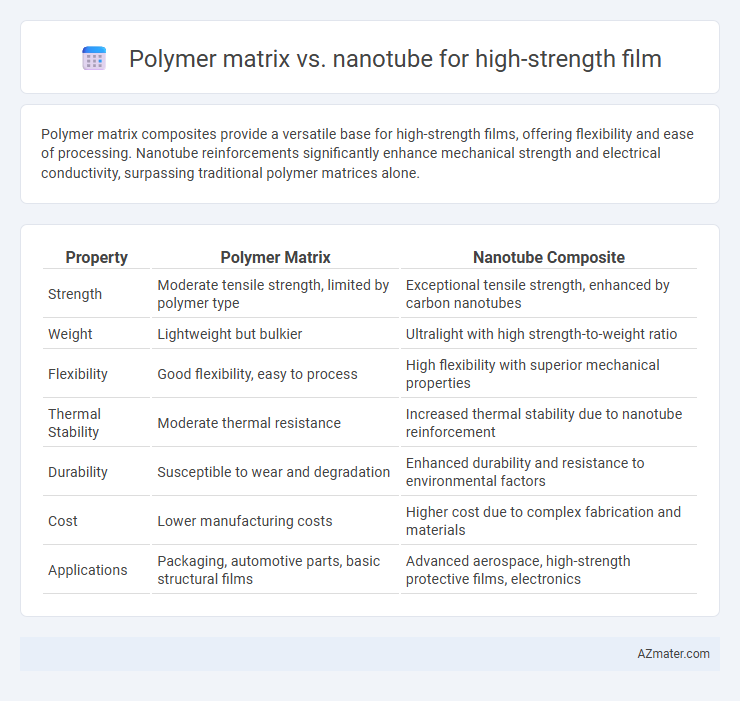Polymer matrix composites provide a versatile base for high-strength films, offering flexibility and ease of processing. Nanotube reinforcements significantly enhance mechanical strength and electrical conductivity, surpassing traditional polymer matrices alone.
Table of Comparison
| Property | Polymer Matrix | Nanotube Composite |
|---|---|---|
| Strength | Moderate tensile strength, limited by polymer type | Exceptional tensile strength, enhanced by carbon nanotubes |
| Weight | Lightweight but bulkier | Ultralight with high strength-to-weight ratio |
| Flexibility | Good flexibility, easy to process | High flexibility with superior mechanical properties |
| Thermal Stability | Moderate thermal resistance | Increased thermal stability due to nanotube reinforcement |
| Durability | Susceptible to wear and degradation | Enhanced durability and resistance to environmental factors |
| Cost | Lower manufacturing costs | Higher cost due to complex fabrication and materials |
| Applications | Packaging, automotive parts, basic structural films | Advanced aerospace, high-strength protective films, electronics |
Introduction to High-Strength Films
High-strength films rely on materials like polymer matrices and nanotubes to achieve enhanced mechanical properties. Polymer matrices provide flexibility and ease of processing, while nanotubes contribute exceptional tensile strength and stiffness due to their atomic-scale structure. Combining polymer matrices with carbon nanotubes creates composite films optimized for superior durability and performance in advanced applications.
Overview of Polymer Matrix Materials
Polymer matrix materials for high-strength films primarily include thermoplastics and thermosetting polymers such as polyethylene terephthalate (PET), polyimides, and epoxy resins, known for their excellent mechanical properties and processability. These polymers provide a flexible yet durable matrix, enabling uniform stress distribution and enhancing toughness in composite films. Their intrinsic chemical resistance and thermal stability are critical for applications demanding robust performance in high-strength film fabrication.
Nanotubes: Structure and Significance
Nanotubes, particularly carbon nanotubes (CNTs), possess a cylindrical nanostructure composed of graphene layers rolled into seamless tubes, providing exceptional tensile strength and electrical conductivity. Their high aspect ratio and unique mechanical properties make them ideal for reinforcing high-strength films, significantly enhancing durability, flexibility, and thermal stability. Incorporating nanotubes into polymer matrices transforms the composite material, enabling advanced applications in aerospace, electronics, and flexible displays where superior strength-to-weight ratios are critical.
Comparative Mechanical Properties
Polymer matrix composites exhibit high tensile strength and good flexibility, making them suitable for various high-strength films, while carbon nanotube-reinforced films demonstrate exceptional mechanical properties such as superior tensile modulus, enhanced fracture toughness, and improved strain-to-failure ratios. Nanotube films outperform polymer matrices in terms of stiffness and strength-to-weight ratio due to the intrinsic properties of CNTs like high aspect ratio and excellent load transfer capabilities. The integration of nanotubes within polymer matrices results in hybrid films combining the ductility of polymers with the unmatched mechanical reinforcement provided by nanotubes, optimizing overall film durability and performance.
Fabrication Techniques: Polymer Matrix vs Nanotube
Polymer matrix films are typically fabricated using solution casting, melt extrusion, or layer-by-layer assembly, enabling uniform dispersion of reinforcing agents for enhanced mechanical properties. Nanotube-based high-strength films are commonly produced via chemical vapor deposition (CVD), electrospinning, or vacuum filtration, techniques that facilitate alignment and networking of nanotubes to maximize tensile strength and stiffness. Compared to polymer matrices, nanotube fabrication methods demand precise control over nanotube orientation and interfacial bonding to achieve superior film performance.
Weight and Density Considerations
Polymer matrix composites generally offer lower density and lighter weight compared to traditional materials, making them ideal for high-strength film applications where weight reduction is critical. Carbon nanotube (CNT) reinforced films provide exceptional strength-to-weight ratios due to the ultralight and high-modulus properties of nanotubes, resulting in films with significantly enhanced mechanical performance without substantial weight increase. Weight and density considerations favor CNT-reinforced polymer matrices for applications demanding maximum strength at minimal weight, as they outperform conventional polymer films in stiffness and durability per unit mass.
Flexibility and Toughness Analysis
Polymer matrix composites exhibit excellent flexibility due to their inherent ductile nature, allowing for greater elongation before failure, while nanotube-reinforced films provide superior toughness through enhanced load transfer and crack resistance at the nanoscale. The integration of carbon nanotubes significantly improves the fracture toughness and tensile strength of polymer matrices by hindering crack propagation and increasing energy dissipation during mechanical deformation. Balancing the polymer matrix's flexibility with the nanotube's reinforcement effect results in high-strength films optimized for applications requiring both durability and pliability.
Cost and Scalability Factors
Polymer matrix composites generally offer lower production costs and easier scalability compared to nanotube-reinforced films, which require sophisticated synthesis and alignment processes. The high cost of carbon nanotubes, along with challenges in mass production and uniform dispersion, limits their commercial scalability despite superior mechanical properties. Polymer matrices benefit from established manufacturing methods like extrusion and molding, making them more cost-effective for large-scale production of high-strength films.
Application Suitability and Performance
Polymer matrices provide excellent flexibility and processability for high-strength films, making them highly suitable for applications requiring lightweight and corrosion-resistant materials such as packaging and flexible electronics. Nanotube-reinforced films offer superior mechanical strength, thermal conductivity, and electrical properties, ideal for demanding applications in aerospace, automotive, and advanced electronics where enhanced durability and multifunctionality are critical. The combination of polymer matrices with nanotube reinforcement maximizes performance by leveraging polymer flexibility and nanotube strength, optimizing films for high-performance applications.
Future Trends in High-Strength Film Technologies
Nanotube-reinforced composites are poised to revolutionize high-strength film technologies by offering exceptional mechanical strength, thermal stability, and lightweight characteristics compared to traditional polymer matrices. Emerging trends emphasize the integration of carbon nanotubes with advanced polymer matrices to achieve superior tensile strength and enhanced durability for aerospace, automotive, and flexible electronics applications. Future developments focus on scalable manufacturing processes and functionalization techniques to optimize nanotube dispersion and interfacial bonding, maximizing performance in next-generation high-strength films.

Infographic: Polymer matrix vs Nanotube for High-strength film
 azmater.com
azmater.com